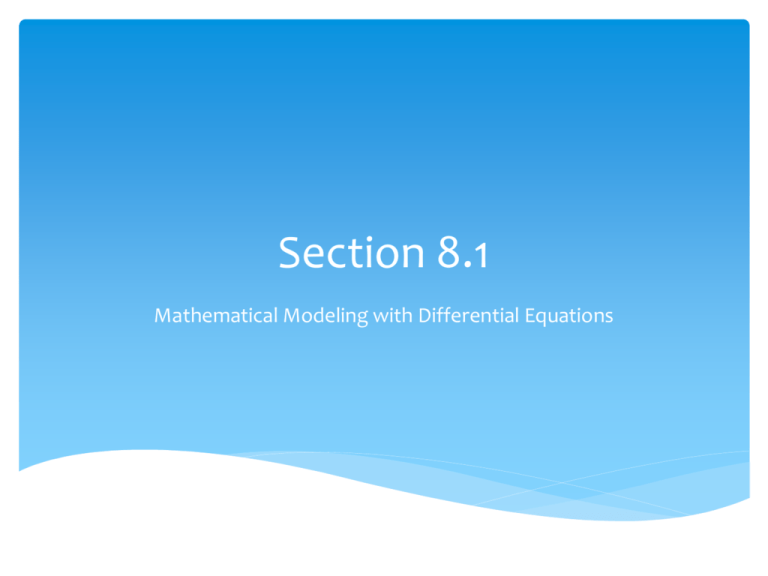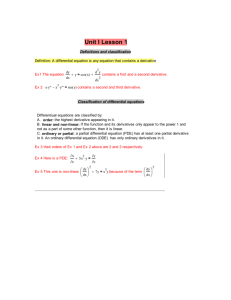
Section 8.1
Mathematical Modeling with Differential Equations
All graphics are attributed to:
Calculus,10/E by Howard Anton, Irl Bivens, and
Stephen Davis
Copyright © 2009 by John Wiley & Sons, Inc. All
rights reserved.
Introduction
Many fundamental laws of science and engineering can be
expressed in terms of differential equations.
We introduced the concept last class, today we will go into
more detail.
We will discuss some important mathematical models that
involve differential equations, and discuss some methods
for solving and approximating solutions of some basic
differential equations.
Note: There are entire courses in college devoted to
differential equations.
Terminology
A differential equation is an equation involving one or
more derivatives of an unknown function (we will use
y = y(x) unless it is a function of time, for which we
will use y = y(t)).
The order of a differential equation is the order of the
highest derivative that it contains.
In the table at the right, for example,
the highest order derivative in the last
equation y” + y’ = cos t is y” comes from
the y” term. Therefore, the order is 2
since it is the second derivative.
Solutions of Differential Equations
A function y = y(x) is a solution of a differential
equation on an open interval if the equation is
satisfied identically on the interval when y and its
derivatives are substituted into the equation.
Example: y = e 2x is a solution of dy/dx – y = e 2x
because it “works” when we substitute y = e 2x and
its derivative dy/dx = e 2x * 2 (don’t forget chain rule).
dy/dx – y = e 2x
2 e 2x - e 2x = e 2x
2 e 2x - 1e 2x = e 2x
1e 2x
= e 2x
substitution
put in coefficient 1
combine like terms
General Solutions of Differential
Equations
While we saw on the last slide that y = e 2x is a solution of
dy/dx – y = e 2x, it is not the only solution that “works” when
we substitute y and its derivative dy/dx into dy/dx – y = e 2x.
y = e 2x +Ce x (general solution, see below) is also a solution
for every real value of the constant C.
dy/dx – y = e 2x
2 e 2x + Ce x – (e 2x +Ce x) = e 2x
2 e 2x + Ce x – 1e 2x - Ce x = e 2x
1e 2x + 0
= e 2x
substitution
distribute & put in coeff. 1
combine like terms
On a given interval, a solution of a differential equation from
which all solutions on that interval can be derived by
substituting values for arbitrary constants is called a general
solution of the equation on the interval.
Integral Curve
The graph of a solution of a differential equation is called
an integral curve for the equation.
It is often a family of integral curves corresponding to the
different possible choices for C.
Some integral curves for the example we
have been discussing:
Initial-Value Problems
When an applied problem leads to a differential equation
(examples to follow), there are usually conditions in the
problem that determine specific values for the arbitrary
constants.
As a rule of thumb, it requires one condition for each
constant to be able to solve.
For a first order equations, the initial condition is often
given y(x0) = y0.
This is called solving a first-order initial-value problem and
it forces the solution to be the integral curve which passes
through the point (x0, y0).
Example of a First-Order Initial-Value
Problem
Find the solution to the differential equation we were
using earlier dy/dx – y = e 2x which has an initial value
of 3 (means y(0) = 3 and point is (0,3)).
y = e 2x +Ce x
3 = e 2(0) +Ce (0)
3 = e 0+Ce 0
3 = 1+C*1
2=C
y = e 2x +2e x
general solution from slide #6
substitution (0,3)
multiply
n 0 = 1, NOTE: 0 0 is undefined
solve for C
specific solution through (0,3)
Applications
Since many important principles in the physical and
social sciences involve rates of change, the principals
can often be modeled by differential equations.
Some examples we will discuss now are:
Uninhibited Population Growth
Pharmacology
Spread of Disease
Newton’s Law of Cooling
Vibrations of Springs
Uninhibited Population Growth
One of the simplest models of population growth is based
on the observation that when populations (people, plants,
bacteria, and fruit flies for example) are not constrained by
environmental limitations, they tend to grow at a rate
(called dy/dt) that is proportional to the size of the
population-the larger the population, the more rapidly it
grows.
This is described by the differential equation:
dy/dt = ky
If you know the population at some point, we can obtain a
formula for the population by solving the initial-value
problem as we did on slide #9:
dy/dt = ky, y(0) = y0
Inhibited Population Growth;
Logistic Models
Uninhibited population growth is only reasonable as long
as the size of a population is relatively small,
environmental effects become increasingly important as
the population grows because an ecological system can
only support a certain number of individuals, L.
L is called the carrying capacity of the system.
When the population (y) is bigger than the carrying
capacity (y>L), the population tends to decrease toward L.
When y<L, the population is below capacity and tends to
increase towards L.
When y=L, the population is in balance with the ecological
systems and tends to remain stable.
Population Growth; Logistic Model
Mathematically
Population (y) compared to Ratio of population (y) to
carrying capacity (L) given carrying capacity (L)
y>0 and L>0
Population growth rate
𝑑𝑦
𝑑𝑡
y is far below carrying
capacity
uninhibited population
𝑦
growth when 𝐿 is approx. 0
y<L
𝑦
<1
𝐿
𝑑𝑦
𝑑𝑡
y>L
𝑦
>1
𝐿
𝑦
=1
𝐿
𝑑𝑦
𝑑𝑡
𝑑𝑦
𝑑𝑡
y=L
= ky approximately
> 0, increases
< 0, decreases
= 0, remains stable
A differential equation (“the logistic differential equation”) that meets all of these
𝑑𝑦
𝑦
requirements is 𝑑𝑡 = k(1 - 𝐿 )y which can be determined by solving the initial-value
problem given y(0) = y0.
Pharmacology
When a drug is administered to an individual, it enters
the bloodstream and then is absorbed by the body
over time.
Research shows that the amount of the drug in the
bloodstream tends to decrease proportionately to
the amount of the drug present.
𝑑𝑦
𝑑𝑡
= −𝑘𝑦, 𝑦 0 = 𝑦0
Spread of Disease
When a disease begins to spread in a population of L
individuals, the rate at which the disease spreads will
depend upon how many individuals are already affected
(y) and how many are not (L-y).
As more individuals are affected, the opportunity to spread
the disease tends to increase.
At the same time, there are fewer individuals who are not
affected so the opportunity to spread decreases.
This produces conflicting influences on the rate at which the
disease spreads.
Mathematical Model:
𝑑𝑦
= ky(L – y)
𝑑𝑡
Note: this can be viewed as a logistic model when
rewritten
Newton’s Law of Cooling
If a hot object is placed into a cool environment, it will cool at a
rate proportional to the difference in temperature between the
object T and the environment 𝑇𝑒 .
Mathematical Model:
𝑑𝑇
𝑑𝑡
= k(T – 𝑇𝑒 )
Similarly, if a cold object is placed into a warm environment, the
object will warm at a rate that is proportional to the difference
in temperature between the object T and the environment 𝑇𝑒 .
Vibrations of Springs
If a block of mass m is attached to the end of a horizontal spring
and is pulled beyond its natural position and released, Hooke’s
Law gives us the restoring force –kx(t) (pictures on page 565).
Newton’s Second Law of Motion leads us to restoring force
being equal to the product of the mass and the acceleration of
the mass (second derivative).
Mathematical Model:
𝑑2 𝑦
m 2
𝑑𝑡
= −𝑘𝑥
Since this is a second order differential equation for x, we need
two conditions to solve: 𝑥 0 = 𝑥0 and x’(0) = 0.








